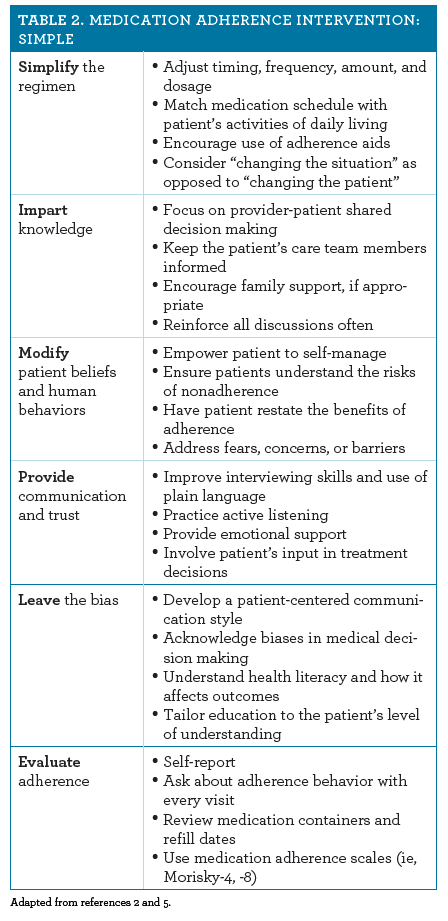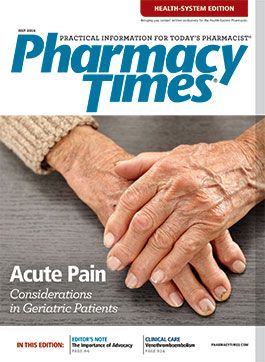Publication
Article
Pharmacy Practice in Focus: Health Systems
Discussing Medication Adherence with a Hospitalized Patient
Author(s):
Medication adherence is defined as the act of patients taking their medications as prescribed by their health care provider.
Medication adherence is defined as the act of patients taking their medications as prescribed by their health care provider.1,2 The term adherence refers to a collaboration between a patient and a health care provider in which they mutually agree upon a course of treatment to produce a positive therapeutic result. Persistent medication nonadherence leads to emergency department visits, hospitalizations, and mortality; it is also associated with a high economic burden and poor clinical outcomes. In addition, medication nonadherence can increase the risk of hospital readmissions.1-3 According to the National Association of Chain Drug Stores, 50% to 70% of patients who receive a prescription take it to the pharmacy for processing, and 48% to 66% of those patients pick up their medications.2 Alarmingly, only 25% to 30% of patients take their medications properly, whereas 15% to 20% of patients refill their medications as prescribed.
Methods to Improve Medication Adherence
The World Health Organization has proposed 5 interacting dimensions that affect adherence (Table 1).2,4 Strategies to enhance medication adherence include a series of interventions known by the acronym SIMPLE (Table 2).2,5 These strategies are typically incorporated into medication therapy management (MTM) services. MTM services have become widely recognized as an integral and vital part of patient care, with improvements being shown in clinical, economic, and humanistic outcomes.6
MTM is a comprehensive, patient-centered counseling service provided by a health care practitioner in collaboration with a patient and health care team members. MTM services have 2 parts: therapeutics and patient counseling. The therapeutics component is for assessing the appropriateness of a patient’s medication regimen according to evidence-based guidelines. The counseling component is for educating and empowering patients to take an active role in their medical management.

Pharmacist’s Role in Medication Adherence
Pharmacist-provided services, such as medication reconciliation and MTM, both components of transitions of care, have been shown to have a positive effect on the management of multiple disease states and to reduce 30-day hospital readmission rates.7-9 MTM services are provided by pharmacists in various health care settings, especially in ambulatory care6; other settings include acute care, long-term care, home care, and managed care. Each setting requires the tailoring of services to fit a patient’s present and potential needs, while maintaining the 5 core elements of pharmacist-provided MTM services:
- Medication therapy review
- Personal medication record
- Medication-related action plan
- Intervention and/or referral
- Document and follow up
Not all settings are equal in terms of the availability of patient information required to provide comprehensive MTM services.6,10 Data-poor environments, such as community pharmacies, maintain important subjective information, such as patient allergy and medication profiles, refill histories, demographics, and insurance coverage. However, pharmacists working in data-poor environments are faced with multiple information-gathering challenges, such as inaccessible medical/discharge records (objective data), reliance on patients for providing a full medical history (recall bias, memory lapse), and medication lists built by prescription transactions instead of a confirmed, prescribed medication list. Other limitations include the retrospective identification of medication discrepancies, physician time constraints, and difficulty reaching physicians.
Pharmacists working in data-rich environments, such as hospitals, long-term care facilities, and medical clinics, have full access to objective patient information necessary to provide comprehensive MTM services.6,10 Hospital charts contain objective information, such as diagnoses, around-the-clock physical examinations, vitals, medications administered, laboratory and test results, and, possibly, a discharge plan. In a hospital setting, physicians and supporting health care team members are relatively more accessible for discussing patient therapy plans with the pharmacists. In addition, therapy modifications can be implemented immediately and prospectively, potentially avoiding an adverse event in the community.
Hospital Pharmacists and Adherence Counseling
Hospital pharmacists may begin the patient counseling and empowerment portion of MTM as a patient approaches treatment completion. During this time, counseling may relieve some of the information and instruction overload that patients typically experience during the discharge process. In addition, patient education can be reinforced during the discharge process to help patients remember their instructions. Developing a patient-pharmacist relationship early may help alleviate premature anxiety regarding self-management, and other patient-related factors that can lead to medication nonadherence.2,4,5
A hospital setting can never replace MTM services provided in an outpatient setting, whether it is a data-rich or data-poor environment; however, the hospital setting is a good place to start. Inpatient counseling may extend the transition-of-care timeline, but follow-up care is always necessary to ensure that inpatient MTM efforts are worthwhile and beneficial. Although pharmacists have proved to be valuable MTM providers, a multidisciplinary effort involving collaboration among the patient and the health care team members will always be required to ensure safety, efficacy, and the best overall health outcomes.
Case Study
Day 1. CB is a 42-year-old man admitted to the hospital for new-onset atrial fibrillation. He is initiated on intravenous (IV) diltiazem for rate control and IV unfractionated heparin for anticoagulation. The patient is currently stabilized, and is alert and oriented.
- How will you discuss with the patient his current medication regimen for new-onset atrial fibrillation?
Day 2. CB is maintained in sinus rhythm overnight and is converted to oral diltiazem ER 180 mg once a day and apixaban 5 mg twice a day. The date of discharge remains undetermined, and no discharge treatment plan is set up at this time.
- What will you discuss with the patient to prepare him for self-management after discharge? What questions will you ask to assess the patient’s medication adherence barriers?
Day 3. CB will be discharged this afternoon with diltiazem ER 240 mg once a day and apixaban 5 mg twice a day. The patient feels he can trust you, and decides to admit that he is illiterate.
- How will you assist the patient in overcoming this adherence barrier? What recommendations do you have to help the patient overcome this adherence barrier after discharge?
Dr. Chu is an internal medicine pharmacist specializing in transitions of care and anticoagulation therapy management at Swedish Covenant Hospital, Chicago, Illinois.
References
- Ho PM, Bryson CL, Rumsfeld JS. Medication adherence: its importance in cardiovascular outcomes. Circulation. 2009;119(23):3028-3035. doi: 10.1161/CIRCULATIONAHA.108.768986.
- Medication adherence time tool: improving health outcomes. American College of Preventive Medicine website. acpm.org/?MedAdherTT_ClinRef. Published 2011. Accessed February 21, 2016.
- Koeler BE, Richter KM, Youngblood L, et al. Reduction of 30-day post discharge hospital readmission or emergency department (ED) visit rates in high-risk elderly medical patients through delivery of a targeted care bundle. J Hosp Med. 2009;4(4):211-218. doi: 10.1002/jhm.427.
- Adherence to long-term therapies: evidence to action. World Health Organization website. apps.who.int/medicinedocs/pdf/s4883e/s4883e.pdf. Published January 2003. Accessed February 15, 2016.
- Medication adherence. CDC website. cdc.gov/primarycare/materials/medication/docs/medication-adherence-01ccd.pdf. Published March 27, 2013. Accessed February 15, 2016.
- Medication Therapy Management in Pharmacy Practice: Core Elements of an MTM Service Model. Version 2.0. American Pharmacists Association and the National Association of Chain Drug Stores Foundation; March 2008.
- Gilberson S, Yoder S, Lee MP. Improving patient and health system outcomes through advanced pharmacy practice: a report of the US surgeon general. Office of the Chief Pharmacist. US Public Health Service; Dec 2011.
- Yoder VG, Dixon DL, Barnette DJ, Beardsley JR. Short-term outcomes of an employer sponsored diabetes management program at an ambulatory care pharmacy clinic. Am J Health Syst Pharm. 2012;69(1):69-73. doi: 10.2146/ajhp110041.
- Morello CM, Zadvorny EB, Cording MA, Suemoto RT, Skog J, Harari A. Development and clinical outcomes of pharmacist-managed diabetes care clinics. Am J Health Syst Pharm. 2006;63(14):1325-1331.
- Stebbins MR, Cutler TW, Parker PL. Assessment of therapy and medication therapy management. In: Alldredge BK, Corelli RL, Ernst ME, et al. Koda-Kimble and Young’s Applied Therapeutics: The Clinical Use of Drugs. 10th ed. Baltimore, MD: Wolters Kluwer Health/Lippincott Williams & Wilkins; 2013.







